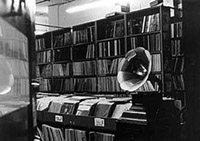 If there’s anything that the 26 new CDs featured in SoundTracks this month have in common it’s their inability to be pigeonholed. Taken together, they are proof of how far ranging American music is.
If there’s anything that the 26 new CDs featured in SoundTracks this month have in common it’s their inability to be pigeonholed. Taken together, they are proof of how far ranging American music is.
While it seems ironic that the most futuristic sounding music that came across our desks this month were discs collecting early tape works by Ingram Marshall and the late Kenneth Gaburo , it’s downright shocking to discover the music of Thomas Wiggins, a.k.a. “Blind Tom ” Bethune, a 19th century piano wizard born into slavery whose original compositions incorporate polytonality, tone-clusters and other modernisms long thought to be alien to American music until Charles Ives! This month we’ve had a veritable avalanche of 19th century American repertoire. In addition to the standout “Blind Tom” CD, there are three new discs of Creole concert works from New Orleans featuring works by the celebrated Louis Moreau Gottschalk , and the almost totally unknown African Americans Edmond Dédé , Charles Lucièn Lambert Sr. and his son Lucièn-Léon Guilliaume Lambert Jr. Their music, which includes mazurkas and quadrilles and homages to Napoleon III, shows what a melting pot America was even two centuries ago. A gorgeous disc of brand new works by Asian American composers shows how musical traditions from all over the world continue to enrich our culture.
Traditional roots American folk music also continues to inspire a variety of new music projects. Jay Ungar and Molly Mason ‘s new disc blends Appalachian and Cajun folksongs with a chamber orchestra and the latest recording by the early music group Hesperus pairs European Medieval and Renaissance music with “early” American folk and blues repertoire by Uncle Dave Macon, Robert Johnson and others. NewGrange , a new progressive bluegrass supergroup featuring Darol Anger, Mike Marshall, Tim O’Brien and keyboardist (!) Philip Aaberg, combines so many different aesthetics it’s hard to know where it will go from one track to the next. Songs from a Random House , an eclectic avant-folk band led by Steven Swartz, mixes pop melodic hooks with a totally experimental musical vocabulary combining hexatonic harmonies with bizarre instrumentation (starring electrified baritone ukelele).
Pop sensibilities are even more pronounced in the attitude and appearance of the new Absolute Ensemble , who’ve even been featured in Vogue Magazine, but who perform a steady diet of post-modern concert repertoire including works by John Adams, Michael Daugherty, and others. Robert Ashley ‘s latest “opera” makes the line between downtown experimentalism and popular culture even blurrier with a work that contains “songs” that would even get pop radio airplay if radio were not governed so tightly by statistical marketing research.
A new disc by the John Link Vocal Quintet further shows the versatility of the voice in original “instrumental works” for voices as well as vocal transcriptions of music by Mussorgsky, Satie, Chick Corea and others.
Labeling the recent jazz recordings included here as jazz also limits their scope. Keyboardist D.D. Jackson , while clearly operating within a jazz framework, incorporates the unusual sonories of electric violin and African percussion into his combo. Greg Osby ‘s new recording combines two generations of players: today’s neo-hard bop-oriented “Young Lions” with masters of the free jazz era: Andrew Hilll and Jim Hall. The Bruce Arnold Trio performs jazz based on 12-tone rows resulting in music that sounds very un-Schoenbergian. Chick Corea , whose compositions have always blended elements of classical music, jazz, Latin and rock, has written a Piano Concerto. A new “big band” disc by Scott Rosenberg all but erases the line between notated experimental ensemble music and free improv. And the music of Meyer Kupferman , a contemporary classical music composer who has written a large body of compositions, is featured on two discs, one devoted exclusively to jazz-influenced works .
The saxophone, an instrument long associated with jazz, continues to prove itself remarkably versatile in a new disc of saxophone quartets featuring the music of six different composers. More versatile, still, is the music being created for dance these days. A new 2-CD sampler featuring dance music by seven different composers offers a good cross-section of the variety.
Tan Dun ‘s Millennium Symphony, which is something of a classical music answer to “We Are The World,” literally incorporates musicians and musical traditions from all six inhabited continents. Several of the works on another orchestral disc, devoted to the music of David Sampson , take their inspiration from other important historic events, the assassination of JFK, the Vietnam War Memorial in Washington DC.
Finally, a new disc of solo piano music by Matthew Goodheart , mixes a wide range of styles, from inside-the-piano expressionism to harmelodic jazz, with an economy of means. Listen in…










